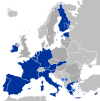- General Court (European Union)
-
General Court Established 1989 Jurisdiction European Union Location Luxembourg, Luxembourg Website [1] European Union 
This article is part of the series:
Politics and government of
the European UnionPolicies and issuesThe General Court (EGC) is a jurisdictional instance of the Court of Justice of the European Union. From its inception on 1 January 1989 to 30 November 2009, it was known as the Court of First Instance (CFI).
Contents
Competence
The General Court hears disputes (such as disputes brought by those refused a trademark by OHIM, the EU Trade Mark and designs registry). Appeals are sent to the European Court of Justice. The General Court is an independent Court attached to the European Court of Justice.
The creation of the General Court instituted a judicial system based on two levels of jurisdiction: all cases heard at first instance by the General Court may be subject to a right of appeal to the Court of Justice on points of law only.
In view of the increasing number of cases brought before the General Court in the last five years, in order to relieve it of some of the caseload, the Treaty of Nice, which entered into force on February 1, 2003, provides for the creation of ‘judicial panels’ in certain specific areas.
On November 2, 2004 the Council adopted a decision establishing the European Union Civil Service Tribunal. This new specialised tribunal, composed of seven judges, will hear and determine at first instance disputes involving the European Civil Service. Its decisions will be subject to a right of appeal before the General Court on points of law only. Decisions given by the General Court in this area may exceptionally be subject to review by the Court of Justice. The European Union Civil Service Tribunal was duly constituted into law on December 2, 2005.
The creation of a European Union Patent Tribunal is currently being examined.
Composition
The General Court (previously known as the "Court of First Instance") is composed of 27 judges, at least one from each Member State, plus a registrar. The Judges are appointed for a renewable term of six years by common accord of the governments of the Member States.
The Members of the General Court elect their President and the Presidents of the Chambers of five Judges from among their number for a renewable period of three years.
There are no permanent Advocates General attached to the General Court (unlike the European Court of Justice which has 8 Advocates General). However, the task of an Advocate General may be performed in a limited number of cases by a Judge nominated to do so. In practice this has been done only very occasionally.
List of presidents
Year Name 1989–1995  José Luis Da Cruz Vilaça
José Luis Da Cruz Vilaça1995–1998  Antonio Saggio
Antonio Saggio1998–2007  Bo Vesterdorf
Bo Vesterdorf2007–present  Marc Jaeger
Marc JaegerJudges
Name Country Elected Term Ends Marc Jaeger  Luxembourg
Luxembourg1996 2010 Josef Azizi  Austria
Austria1995 2013 Arjen Meij  Netherlands
Netherlands1998 2010 Dimitris Gratsias  Greece
Greece2010 2016 Nicholas James Forwood  United Kingdom
United Kingdom1999 2011 Maria Eugénia Martins de Nazaré Ribeiro  Portugal
Portugal2003 2015 Franklin Dehousse  Belgium
Belgium2003 2015 Ena Cremona  Malta
Malta2004 2010 Ottó Czúcz  Hungary
Hungary2004 2010 Irena Wiszniewska-Białecka  Poland
Poland2004 2010 Irena Pelikánová  Czech Republic
Czech Republic2004 2010 Daniel Šváby  Slovakia
Slovakia2004 2010 Vilenas Vadapalas  Lithuania
Lithuania2004 2010 Küllike Jürimäe  Estonia
Estonia2004 2010 Ingrida Labucka  Latvia
Latvia2004 2010 Savvas S. Papasavvas  Cyprus
Cyprus2004 2010 Enzo Moavero Milanesi  Italy
Italy2006 2012 Nils Wahl  Sweden
Sweden2006 2012 Miro Prek  Slovenia
Slovenia2006 2013 [1] Mariyana Kancheva  Bulgaria
Bulgaria2011 2013 Andrei Popescu  Romania
Romania2010 2016 Alfred Dittrich  Germany
Germany2007 2013 Santiago Soldevila Fragoso  Spain
Spain2007 2013 Laurent Truchot  France
France2007 2013 Sten Frimodt Nielsen  Denmark
Denmark2007 2013 Kevin C.O'Higgins  Ireland
Ireland2008 2013 Heikki Kanninen  Finland
Finland2009 2015 Juraj Schwarcz  Slovakia
Slovakia2009 2015 Emmanuel Coulon (registrar) [1]  France
France2005 2011 Former Judges
Name Country Elected Term Ended Ref. Virpi Tiili  Finland
FinlandJanuary 8, 1995 October 6, 2009 [2] References
- "General Court: Presentation of the members". European Court of Justice. http://curia.europa.eu/jcms/jcms/Jo2_7035/.
Jurisdiction
The General Court, like the Court of Justice, has the task of ensuring that the law is observed in the interpretation and application of the Treaties of the European Union and the provisions adopted by the competent Union institutions.
In order to fulfil its main task, the General Court has jurisdiction to hear and determine at first instance all direct actions brought by individuals and the Member States, with the exception of those to be assigned to a ‘judicial panel’ and those reserved for the Court of Justice.
Categories of direct actions
- Actions for annulment
(against acts of the Union institutions)
- Actions for failure to act
(against inaction by the Union institutions)
- Actions for damages
(for the reparation of damage caused by unlawful conduct on the part of a Union institution)
- Actions based on an arbitration clause
(disputes concerning contracts in public or private law entered into by the Union, containing such a clause)
- Actions concerning the civil service - As of 2006 these cases were transferred to the new Civil Service Tribunal
(disputes between the Union and its officials and other servants)
Subject-matter of direct actions: all matters, including:
- agriculture
- State aid
- competition
- commercial policy
- regional policy
- social policy
- institutional law
- trade mark law
- transport
Procedure
The General Court has its own Rules of Procedure. As a rule the Court’s procedure includes a written phase and an oral phase. The proceedings are in a language chosen by the applicant. The working language of the Court, however, including the language in which the judges deliberate and the language in which preliminary reports and judgments are drafted is French. This makes the General Court, along with the Court of Justice of the European Union, the only international court where French is the sole working language [2]
The Court is divided into eight chambers, generally consisting of three judges, except for the sixth and the eighth chambers, which consist of four judges and alternate to form three-judge chambers for the purposes of dealing with cases [3]. Cases are distributed by the President of the Court to the Presidents of the chambers. The Presidents of chamber then assign a Judge-Rapporteur amongst the judges in the chamber, whose clerks write a preliminary report (rapport prealable) based on the pleadings received from the parties and the applicable law.
At the close of the written procedure and, as the case may be, on adoption of measures of inquiry, the case is argued orally in open court. The proceedings are interpreted simultaneously, as necessary, into different official languages of the European Union. The Judges then deliberate on the basis of a draft judgment prepared by the Judge-Rapporteur. The judgment is delivered in open court.
References
- ^ a b "CURIA - Members". CVRIA. http://curia.europa.eu/jcms/jcms/Jo2_7034/. Retrieved May 2, 2010.
- ^ "CURIA - Former Members". CVRIA. http://curia.europa.eu/jcms/jcms/Jo2_9606/?hlText=Tiili. Retrieved May 2, 2010.
External links
- General Court (official site)
- ECJBlog.com, weblog with daily news about the European Court of Justice and General Court
Court of Justice of the European Union  European Court of Justice (members) · General Court · Civil Service Tribunal · Relationship with ECHR
European Court of Justice (members) · General Court · Civil Service Tribunal · Relationship with ECHRRulings and case law (preliminary ruling) Allonby v Accrington and Rossendale College · Apostolides v Orams · Bosman ruling · Cassis de Dijon · Chacon Navas v Eurest Colectividades SA · Chen case · Ciaran Tobin extradition case · Coleman v Attridge Law · Costa v ENEL · European Union Microsoft competition case · Factortame litigation · Francovich principle · Kamer van Koophandel en Fabrieken voor Amsterdam v Inspire Art Ltd · Kolpak ruling · Tanja Kreil · Marleasing SA v La Comercial Internacional de Alimentacion SA · Metock case · Nordsee case · Palacios de la Villa v Cortefiel Servicios SA · Peter Paul and Others v Bundesrepublik Deutschland · Procureur du Roi v Dassonville · Ralf Sieckmann v Deutsches Patent und Markenamt · Van Duyn v Home Office · Van Gend en Loos · Webster rulingCategories:
Wikimedia Foundation. 2010.






